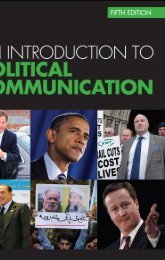Understanding global security - Peter Hough
Understanding global security - Peter Hough
Understanding global security - Peter Hough
You also want an ePaper? Increase the reach of your titles
YUMPU automatically turns print PDFs into web optimized ePapers that Google loves.
CRIMINAL THREATS TO SECURITY<br />
Urbanization<br />
The <strong>global</strong> trend towards urban living is a factor behind the rise of crime since city<br />
dwellers are statistically far more violent and lawless than their rural counterparts.<br />
The homicide rate in Amsterdam is 4.09 per 100,000 people, while the rate for the<br />
whole of the Netherlands is 1.4 (Council of Europe 1999). This pattern is much more<br />
pronounced in LDCs, where far larger sections of the cities’ populations live in poverty<br />
than in wealthy Amsterdam. Poverty, of course, is a key cause of crime and it is in<br />
these areas that world population growth is focused.<br />
The growth of ‘<strong>global</strong> crime’<br />
A key factor in the <strong>global</strong>ization of crime is the increased tendency for organized<br />
criminal groups to follow the lead of transnational corporations and set up operations<br />
in a number of other countries. Cheaper international travel costs favour criminals<br />
as much as they do other profit-seeking individuals. Godson and Williams describe<br />
how transnational criminal organizations can come to utilize a home state from where<br />
they direct operations, a host state where they carry out crimes or sell their produce,<br />
a transportation state where criminal activities will seek to ensure an unhindered<br />
passage of goods to the host state and a service state in countries where favourably<br />
secretive banking laws allow for profits to be secured (Godson and Williams 2000:<br />
115). Hence, a genuinely transnational operation can be established where, for<br />
example, a Colombian-based narcotics gang could secure access to markets in the<br />
USA by bribing Mexican officials to permit the transit of the drugs and then invest<br />
the proceeds in a Cayman Islands offshore bank account.<br />
The growth of <strong>global</strong> criminal alliances<br />
At the 1994 United Nations Conference on Internationally Organized Crime, UN<br />
Secretary-General Boutros-Ghali referred to an ‘empire of criminals’ to highlight<br />
the problem of <strong>global</strong>ly operating criminal gangs and also to illustrate the fact that<br />
many of these organized gangs were cooperating with other, likeminded groups to<br />
extend the reach of their operations. There is a long history of criminal gangs<br />
extending their influence into other countries but this, traditionally, had been in line<br />
with patterns of migration. Hence the mafia’s influence in the USA from the 1930s<br />
followed large-scale Italian migration and, to a far lesser extent, Jamaican yardies and<br />
Hong Kong triads extended operations to the UK from the 1980s. The 1990s,<br />
however, witnessed the increased formation of strategic alliances between transnational<br />
criminal organizations exploiting changing political rather than demographic<br />
circumstances. Phil Williams, the world authority on transnational crime, illustrates<br />
this development clearly:<br />
Colombian–Sicilian networks brought together Colombian cocaine suppliers<br />
with Sicilian groups possessing local knowledge, well-established heroin<br />
distribution networks, extensive bribery and corruption networks, and a<br />
223
















